The Glasgow Subway - A History Part 2 (1978-Present)
Post Modernisation
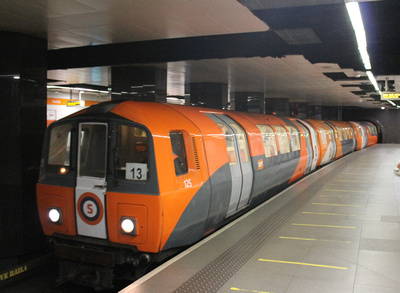
 The far reaching modernisation of the Subway completely transformed the line from an old, antiquated, labour intensive operation to a new, modern and more automated line.
The far reaching modernisation of the Subway completely transformed the line from an old, antiquated, labour intensive operation to a new, modern and more automated line.
The modernisation involved completely revamping the depot, with the original building becoming stabling sheds and a new maintenance shed being constructed. In the original depot building the lifting pit was covered over and the crane was also removed. In the depot yard, a train wash was installed and was shaped to the body shell of the new stock. From the depot yard, the tracks headed to a pair of headshunts, which gave access to both circles via a set of ramps leading to the turnout chambers, which were installed near to the original lifting pit in the tunnels.
In the tunnels, the track was completely replaced, with the original track, sleepers and ballast removed and replaced with track laid in concrete. The obsolete T-iron, the electrified railing that powered the lighting and operated the signalling on the old system was removed. The old signalling system was removed and a new system, which was semi automatic and operated from the newly built control centre at Broomloan Depot.
The stations underwent a complete modernisation with the busier stations being enlarged or gaining side or flank platforms to increase capacity and to ease congestion. Merkland Street station was replaced by a new station called Partick, which was built a short distance away. Partick station became an interchange station with a newly relocated Partick railway station and Partick bus station. The new Partick Underground station was built with side platforms, with escalators down to platform level and was bright, airy and roomy compared to the original Merkland Street station. It is possible to see the site of the old Merkland Street Station, when approaching Partick from Govan and departing Partick for Govan, as mesh fencing can be seen on the right hand side of the tunnel and the sound changes when passing through the old chamber.
Govan Station (formerly Govan Cross) and St Enoch stations had a similar layout to Partick at platform level, with the addition of lifts being installed down to platform level. Ibrox (formerly Copland Road), Hillhead and Buchanan Street were rebuilt with flank platforms on the Outer Circle and the original central platform serving the Inner circle. The remaining stations kept their narrow island platforms and original platform chambers, however, these were extended at all stations except Cowcaddens to allow each station to be able to handle 3 car trains. An emergency exit was installed at the end of the platform where the station master's office was previously located. The chambers were all cladded inside and any previous skylights were covered over giving no natural light in any of the platform chambers.
St Enoch and Buchanan Street stations were rebuilt without surface buildings, only escalators and stairs down to newly built underground ticket halls, with Buchanan Street also having a travelator installed out to the entrance to Queen Street Station.
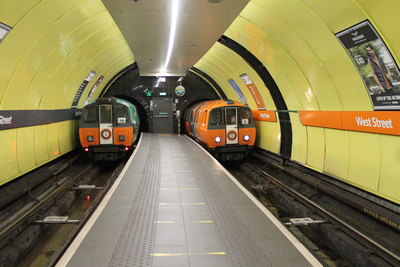
 The original Subway entrance building at St Enoch, a listed building, was retained and was jacked up on a concrete platform and moved a few metres to allow the chamber for the new station to be excavated and built around it. The original station building is no longer connected to the station and after time as a Tourist Information office, it is now a Cafe Nero, with covered escalators and stair cases to the new station built in front of and behind the original building. The only stations to keep their original entrance buildings were Cessnock and Kelvinhall, which are built into existing tenament buildings that were being retained, whilst the original entrance to Kelvinbridge station on South Woodside Road became the fire exit. On reopening, Partick Cross was renamed Kelvinhall, Copeland Road was renamed Ibrox and Govan Cross was renamed to Govan. Buchanan Street station had a nod to the previous system installed, in the form of a shortened version of trailer 41, which had been cut longitudily and mounted a blank area of wall in the ticket hall. Unfortunately this was removed when the station was refurbished in the early 2010s.
The original Subway entrance building at St Enoch, a listed building, was retained and was jacked up on a concrete platform and moved a few metres to allow the chamber for the new station to be excavated and built around it. The original station building is no longer connected to the station and after time as a Tourist Information office, it is now a Cafe Nero, with covered escalators and stair cases to the new station built in front of and behind the original building. The only stations to keep their original entrance buildings were Cessnock and Kelvinhall, which are built into existing tenament buildings that were being retained, whilst the original entrance to Kelvinbridge station on South Woodside Road became the fire exit. On reopening, Partick Cross was renamed Kelvinhall, Copeland Road was renamed Ibrox and Govan Cross was renamed to Govan. Buchanan Street station had a nod to the previous system installed, in the form of a shortened version of trailer 41, which had been cut longitudily and mounted a blank area of wall in the ticket hall. Unfortunately this was removed when the station was refurbished in the early 2010s.
The refurbishment of the stations included the fitting of escalators down to platform level at St Enoch, Govan and Partick and down to ticket hall level at St Enoch, Buchanan Street. Escalators were also fitted from ticket hall level to the intermediate landing at Cowcaddens and Shields Road and from the bridge over the River Kelvin to down to the station building at Kelvinbridge station.
Park and Ride facilities were retained at Kelvinbridge and were also introduced at Bridge Street and Shields Road, with ample spaces being provided, particularly at Shields Road, which is the largest of the three Park and Rides.
The staff were also to receive new uniforms, gone were the bottle green uniforms with black braiding that had been in use from the early days of the Subway (with the black braiding indicating that they were in mourning for Queen Victoria, who died in 1901) with a brown uniform, which looked more like the colours carried by the trains back in the Company days.
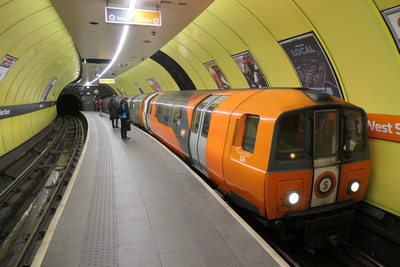
 Metro Cammell Motor Cars
Metro Cammell Motor Cars
For the opening of the modernised system, new trains were required to operate the services. A fleet of 33 driving motors were built by Metro Cammell in Birmingham and began to be delivered to Broomloan depot from 1978 to allow for testing and driver training to commence, initially on a test track above ground and later in the tunnels.
The new cars had a maximum speed of 54 kph (33mph) and were fitted with Automatic Train Operation (ATO), allowing the trains to effectively drive themselves in the tunnels, the only input required from the driver was for them to open and close the doors and press 2 buttons to start the train. The driver's cab side windows were interlocked with the controls, meaning that the train could not move whilst a cab window was open.
The trains were mainly driven in automatic mode in the tunnels unless there was a requirement to drive in manual mode. Manual driving mode was required in the depot area and heading to and from the tunnels to and from either Govan or Ibrox when entering or leaving service. The Metro Cammell stock was a major upgrade on the original stock, they were bright, airy and more spacious than before. Unlike the old stock, which only had doors on the right hand side, the 2nd Gen stock had doors on both sides and when formed into a train, there was a cab at each end, allowing the train to be driven from either cab.
The first car to arrive in Glasgow was no 101, which was displayed on the back of a low loader from 12th-25th June 1977. No 103 was the first to be delivered to Broomloan depot, arriving on 12th January 1978 and being hauled up and down the test track by a battery loco on 19th January 1978. 107 was placed on display at a Strathclyde Transport open day on 16th April 1978. The original livery was all over orange with 'GG' (Greater Glasgow) logos below the drivers cabs and a white band below the windows for the passenger saloons, this was replaced from the mid 1980's with the Strathclyde Transport 'red' livery with black window surrounds.
Battery Locomotives
The original 1930s built battery locomotive from the pre modernised system was deemed unsuitable for further use and was donated to the Glasgow Transport Museum for static display. It's replacement came in the form a pair of Clayton built battery locomotives (numbered L2 and L3) with 48 horse power motors and compatible couplings allowing them to be able to haul both pw wagons and the new Metro Cammell motor cars. Initially, their main task was to haul works trains into the tunnels to assist with track laying and rewiring. An additional pair of Taylor Woodrow battery locos would later join the fleet in 1988 (numbered L4 & L5), however L5 would later be converted to a wagon and renumbered W5.
Royal opening
The modernised underground was formally inagurated on 1st November 1979 by Her Majesty, Queen Elizabeth II despite work to complete the modernisation still being underway and issues with the emergency tunnel telephone system and the ATO system on board the trains causing training to be curtailed. Her Majesty was transported from Buchanan Street to St Enoch via the Outer Circle on board cars 132 and 133. Cars 132 and 133 were chosen as they had recently been delivered thus their paint work was clean and they didn't have wheelflats unlike some of the others that had been used for training.

 Public Opening
Public Opening
Preparations for opening ramped up during early 1980 with shadow running starting on 10th March 1980. The shadow service ran from 6.30am - 7pm Monday - Saturday and used 6 x 2 car trains per circle during peaks and 4 x 2 car trains per circle off peak.
The Modernised system opened to the public on 16th April 1980, with the first passenger service departing from Govan on the Outer Circle at 6.30am. 28,000 passengers used the Underground on the first day of reopening, with an unexpected rush at lunch time as city centre workers decided to have a hurl during their lunch breaks! School finishing time was also busy as school children decided to have a hurl round the system before going home! Before long, the newly reopened Underground, complete with it's new orange trains, gained the nickname, 'Clockwork Orange'
For the first few months, the service operated from 6.30am- 7pm as per the shadow timetable but with 5 trains per circle used on a Saturday afternoon, rather than 4.
The modernised underground settled down with relatively few incidents over the following months, with the most notable incident being car 104 derailing on the points in the turn out chamber when returning to depot from the Outer Circle at the end of service on 4th June 1980. 104 was soon rerailed and the service ran as normal the following day.
From Monday 29th September 1980, the service was extended from 7pm until 10.45pm with 3 trains per circle used from 7pm onwards. In some of the peak journeys it was discovered that the trains were so busy that passengers were being left behind. It was not possible to add more trains into the system so it was decided to make some of them up from 2 cars to 3 cars. The first 3 car trains went into service on 4th November 1980 with 2 trains per circle being made up to 3 cars. The use of 3 car trains meant the use of a met cam power car in the centre of the train with it's motors isolated but with braking still live to ensure that there wasn't a power overload.
On Monday 30th March 1981, the 10,000,000th passenger was carried on the refurbished line. The first full service use of 3 car trains was on 1st June 1982, when Pope John II held an open air mass in Bellahouston Park. The service was formed of 5 x 3 car trains per circle to help take the crowds to and from the event, with 69,500 passengers carried.
Also during 1981 the first change to the livery occured when some of the fleet received brown roofs and door edges with the main body being repainted in a darker shade of orange than the original due to staining occuring from leaks and drips of all sorts in the tunnels. The livery was once again updated in 1983 when the brown was replaced with black and the orange areas became Strathclyde 'Red' while the GG logos were replaced by 'Strathclyde Transport' logos. The windows for the passenger saloons also received a black band around them.
New Trailer vehicles

 During the late 1980s, it was decided that to allow more passengers to be carried, that the majority of trains should be three cars long. This would require 36 cars for the full service, however, there were only 33 cars at this point so more were needed. Rather than ordering more power cars, which would have been more expensive, it was decided that trailers would be just as suitable. Hunslet won the contract to build 8 trailers in 1989. On the outside the trailers were of a similar shape to the Met Cam power cars but without driving cabs, which allowed for 4 extra seats in the interior. Hunslet built the body shells at their Leeds factory, transferring north to their Barclay works in Kilmarnock for fitting out, painting and commissioning. The trailers, numbered 201-208, were delivered to Broomloan Depot between April and August 1992.
During the late 1980s, it was decided that to allow more passengers to be carried, that the majority of trains should be three cars long. This would require 36 cars for the full service, however, there were only 33 cars at this point so more were needed. Rather than ordering more power cars, which would have been more expensive, it was decided that trailers would be just as suitable. Hunslet won the contract to build 8 trailers in 1989. On the outside the trailers were of a similar shape to the Met Cam power cars but without driving cabs, which allowed for 4 extra seats in the interior. Hunslet built the body shells at their Leeds factory, transferring north to their Barclay works in Kilmarnock for fitting out, painting and commissioning. The trailers, numbered 201-208, were delivered to Broomloan Depot between April and August 1992.
After commisioning and test running, which involved bedding in the brakes, and involved running a 5 car set consisting of 3 power cars and 2 trailers to allow 2 trailers to be prepared at a time, the trailers were ready to enter service, with five of them entering service in October 1992 (201, 203, 205 & 206 entered service on 26th October, 207 on 27th October) and the remaining 3 (202, 204 & 208) between November & December 1992. This allowed up to 8 of the trains to be formed with trailers as the centre cars, the remainder, as before used a third Met Cam car acting as a trailer in the centre and most workings became operated by 3 car trains.
Once the trailers were in service, the Met Cam power cars were given a major overhaul at ABB in Derby between 1993 & 1995. This involved a strip down of all the exterior panels, some corrosion repairs, new interior panelling, new flooring and new seating moquette and the installation of the door closing bleepers. Four vehicles were away for refurbishment at a time, starting with 107 and the last car returned was 110.
Flooding
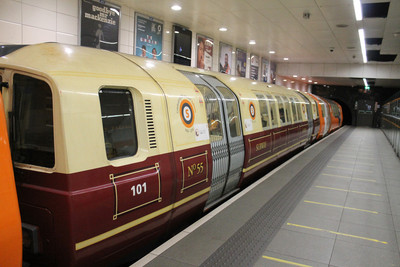
 Heavy rain on 10th and 11th December 1994 had caused flooding in the Kelvinbridge area with Kelvinbridge, St Georges Cross and Cowcaddens stations being closed on 12th and 13th December. Temporary shuttle services were put in place between Ibrox and Buchanan Street and from Govan to Kelvinhall, with the Inner Circle fully reopening on the 14th and Outer on the 16th with speed restrictions in place.
Heavy rain on 10th and 11th December 1994 had caused flooding in the Kelvinbridge area with Kelvinbridge, St Georges Cross and Cowcaddens stations being closed on 12th and 13th December. Temporary shuttle services were put in place between Ibrox and Buchanan Street and from Govan to Kelvinhall, with the Inner Circle fully reopening on the 14th and Outer on the 16th with speed restrictions in place.
Centenary
In 1996, the Underground celebrated it's centenary and to celebrate, former first generation gripper / motor 55, which was retained in store in the depot, was given a cosmetic restoration and put on display outside St Enoch station on 14th December 1996. Unfortunately, it was unable to be taken into the tunnels due to clearances. Meanwhile Metro Cammell Power Cars 122 and 127 were repainted into a representation of the Glasgow District Subway livery carried on the original stock back in 1896.
From around 1997, when Strathclyde Transport became Strathclyde Passenger Transport, SPT logos replaced the Strathclyde Transport logos but the livery remained the same.
In July 2002, SPT took the decision to change the name from Underground back to Subway, with the name change coming into use from October 2002. Despite having changed the name to Underground back in the 1930s, the name never really took off with the public, who some 65 years later were still calling it the Subway, thus it made sense to change the name back and also acknowledge the system's history at the same time. In 2004, the SPT Carmine and Cream livery was introduced to the trains, with gradual relivering of the vehciles taking place.
During 2007 and 2008, the Barclay trailers were transported one at a time to Glasgow Works for refurbishment works / mid life overhaul to take place on them.
More Battery Locos
A further pair of Clayton built battery locomotives were delivered in 2010 to assist with works trains, with another two arriving in 2017 mainly for shunting the new Stadler stock and hauling wiring trains.
Station refurbishments
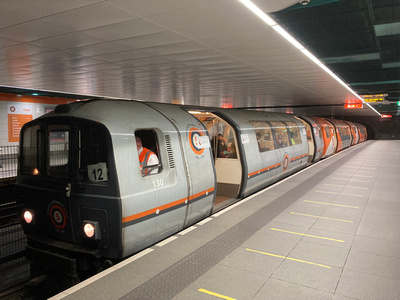
 By the late 2000s, the stations were beginning to become tired and dated so a refurbishment project was planned and was carried out on all the stations to modernise them, with brighter lighting and each station having its own unique colour scheme. The refurbishment work included adding a canopy over the escalators on Buchanan Street as the open nature of this entrance caused regular failures and issues with the escalators. The refurbishment of Buchanan Street also included the removal of ex Subway trailer 41 from its display position in the ticket hall. St Enoch's refurbishment included the fitting of more asthetically pleasing glass canopies covering both entrances.
By the late 2000s, the stations were beginning to become tired and dated so a refurbishment project was planned and was carried out on all the stations to modernise them, with brighter lighting and each station having its own unique colour scheme. The refurbishment work included adding a canopy over the escalators on Buchanan Street as the open nature of this entrance caused regular failures and issues with the escalators. The refurbishment of Buchanan Street also included the removal of ex Subway trailer 41 from its display position in the ticket hall. St Enoch's refurbishment included the fitting of more asthetically pleasing glass canopies covering both entrances.
Around 2010-11 there was once again, a change of livery with the rather busy and not overly popular Carmine and Cream livery giving way a far more modern looking Orange, white and grey livery, which was carried by the majority of the 2nd Generation stock for the remainder of their working lives.
Power Car 122 was withdrawn from service in August 2015 and was later scrapped, but not before donating parts to keep the remaining 32 Met Cam cars in service.
To celebrate the 120th anniversary of the Subway in 2016, Power Car 101 was reliveried into the same representation of the Glasgow District Subway livery carried by the original fleet back in 1896 that was carried by cars 122 and 127 in 1996. As well as car 101's relivery, Power Car 130 was repainted into a special grey livery with orange and black bands on the bodysides to celebrate the anniversary.
Advertising liveries
To bring in some much needed additional revenue to the system, from the late 1990s through to the withdrawal of the G2 cars in 2024, some cars were reliveried into all over adverts, including:
- A 3 car set advertising Call of Duty
- A 3 car set advertising the Setanta TV Channel (125 plus 2 other cars)
- A 3 car set advertising O2
- A 3 car set advertising Morgans Spiced Rum
- Trailer car 203 advertising Clyde 1 and Clyde 2
- A trailer car advertising the bid for the 2014 Commonwealth Games
- A 3 car set advertising Scottish Power/ COP 26 (125+201+118)
- A 3 car set advertising SPT's Net Zero Comittment (132+204+104)
New Trains
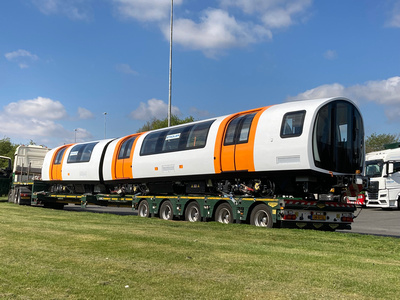
 In 2016, SPT signed a contract with Stadler for the building of 17 new 4 car trains (numbered 301-317), to replace the 1970s built Metro Cammel motor cars and 1990s built Barclay trailers.
In 2016, SPT signed a contract with Stadler for the building of 17 new 4 car trains (numbered 301-317), to replace the 1970s built Metro Cammel motor cars and 1990s built Barclay trailers.
The new stock was built at Stadler's production facility in Altenrheim, Switzerland with the first train being put on display to the public at the Innotrans Rail Trade Fair, Berlin in 2018.
The new 3rd Generation trains are made up in fixed formation and consist of 2 longer outer carriages with 2 shorter centre cars and each train is the same length as a 3 car train of 2nd Gen stock. Some of the new features of the new stock compared to the G2 stock are a better acceleration and braking performance, that they are fully accessible, have spaces for wheelchairs, each vehicle is interconnected, making it possible to walk through the entire set and there is CCTV throughout.
In preparation for the arrival of the new stock, the existing test track at Broomloan Depot was extended up the existing disused trackbed from a former railway, under Edmiston Drive to a temporary testing, commissioning and storage facility set up to prepare the new stock for service. This was required as there was no space in the current depot as the full existing fleet was still in service.
The first new train was delivered to this new facility in May 2019, with a steady flow to follow over the following years, making the journey from Altenrheim by low loader, with a crossing by ferry. Each delivery often involved a long layover at Hamilton services on the M74 and it was often possible to photo them there!
Unfortunately Covid struck mid delivery, mid commisioning and testing on the test track, which caused massive delays to the introduction. It would be 5th December 2021 before the first of the new fleet ventured into the tunnels, with the first train only reaching as far as Govan as it was found that the unit struggled to fit on the existing infrastructure, which would require some ammendments before any further testing underground could take place. The new Stadler sets have been fitted with new signalling equipment to allow them to eventually run driverless, however this is currently inactive, with the trains retrofitted with equipment to allow them to operate within the current signalling system. Just like the Generation 2 cars, the Stadler cars are driven semi-automatically round the system, with the driver being in full control and driving manually both to, from and around the depot.
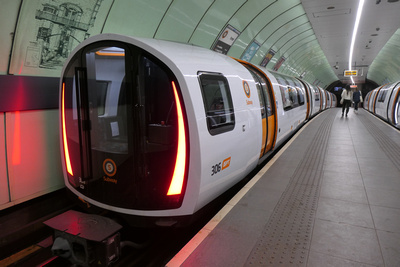
 Entry to service for the new trains began on 11th December 2023, with units 302 and 306 entering service on the Outer circle during mid mornings and initially running on consecutive diagrams to allow them to couple up and rescue the other in the event of a failure. However it was realised that when the units came out of service, it left a large gap between trains while the service was reformed so they were eventually spread out more with G2 unit operating on a diagram in between them! Unit 301 entered service in January 2024 and 303 entered service during February 2024, allowing two trains to operate on each circle at a time, mainly a few hours in the mornings and back out again in the afternoons. 304, 305 & 307 entered service during March and 308 & 309 entered service in April, with 310, 311 & 312 entering service in late May - early June. 316 & 317 made their debuts in July 2024 and 314 & 315 debuting in September 2024 with 16 out of 17 sets now available for service. The final set (313) is still in the process of comissioning and it is expected that once it is handed over to SPT, that it will be held back from service for testing of the new signalling and communications systems.
Entry to service for the new trains began on 11th December 2023, with units 302 and 306 entering service on the Outer circle during mid mornings and initially running on consecutive diagrams to allow them to couple up and rescue the other in the event of a failure. However it was realised that when the units came out of service, it left a large gap between trains while the service was reformed so they were eventually spread out more with G2 unit operating on a diagram in between them! Unit 301 entered service in January 2024 and 303 entered service during February 2024, allowing two trains to operate on each circle at a time, mainly a few hours in the mornings and back out again in the afternoons. 304, 305 & 307 entered service during March and 308 & 309 entered service in April, with 310, 311 & 312 entering service in late May - early June. 316 & 317 made their debuts in July 2024 and 314 & 315 debuting in September 2024 with 16 out of 17 sets now available for service. The final set (313) is still in the process of comissioning and it is expected that once it is handed over to SPT, that it will be held back from service for testing of the new signalling and communications systems.
With the introduction of the Stadler trains in progress, the withdrawal of the Met Cam motors and Barclay trailers commenced. Met Cam motors 115, 127 and 131 were officially withdrawn in early March 2024, having been sidelined for months with various faults.
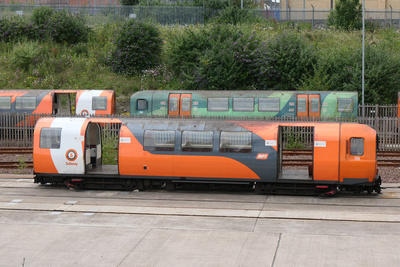
 They were joined by Barclay trailer 208 and Met Cam motors 102, 108, 109, 114 and 123, all of which were shunted from the main Broomloan depot complex, up the test track to the Stadler testing and commissioning facilities at Edmiston Drive for storage until they were removed by low loader to the S Norton Scrapyard at King George V docks for scrapping in early April 2024.
They were joined by Barclay trailer 208 and Met Cam motors 102, 108, 109, 114 and 123, all of which were shunted from the main Broomloan depot complex, up the test track to the Stadler testing and commissioning facilities at Edmiston Drive for storage until they were removed by low loader to the S Norton Scrapyard at King George V docks for scrapping in early April 2024.
A secong batch of withdrawn cars were shunted up to Edmiston Drive during June 2024, these included Trailer 205 and Motors 101, 104, 113, 116 and 132.
Many of the train formations on the Subway tended to remain unchanged for weeks and months at a time and were really only changed over if maintenance was required or for vehicle failures. Here are some of the final formations that were noted over the final few months of service for the 2nd Generation fleet:
119+203+103 106+207+120 128+107+111
132+118+130 124+205+125 121+202+133
126+201+101 117+204+110 109+208+104
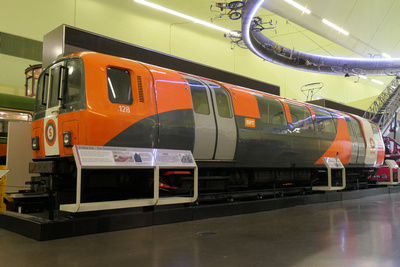
 Preservation of Car 128
Preservation of Car 128
After operating on the Inner Circle on diagram 12 as the rear part of a 3 car formation consisting of 111 (leading), 107 (centre) and 128 (rear) on Monday 10th June 2024, Met Cam Motor 128 was withdrawn from service and was thoroughly cleaned in preparation for its imminent transfer into preservation.
Having been selected as it was in the best condition of the remaining Met Cam motor cars, 128 was loaded onto a low loader on Thursday 13th June and was transferred from Broomloan depot, its home of 44 years, to its new home: Glasgow Riverside Museum where it is now on display in the main hall as a static exhibit!
128 went on public display on Friday 14th June.
Final Withdrawal of the G2 Stock


Final withdrawal came for the G2 stock on Friday 28th June 2024. SPT advertised via social media that the final G2 trains (one per circle) would operate between 1pm and 4pm, however on the day this was extended to almost 5.30pm!
The Subway was very busy with enthusiasts and regular passengers out for one last ride on the old stock, meaning that it was taking longer than usual to do a full circuit with the drivers dwelling longer at stops to allow photos and videos to be taken!
The services operated were Outer Circle (route 6) formed of 119+203+103 and Inner Circle (route 16) formed of 106+207+120. Route 6 (119+203+103) returned to Broomloan Depot first, terminating at Govan and reversing out towards Broomloan depot then shortly after at 17.24 106+207+120 terminated at Govan, then returned to Broomloan depot, with a large crowd of photographers and well wishers out to see them off for the last time.
The fate of the G2 Cars
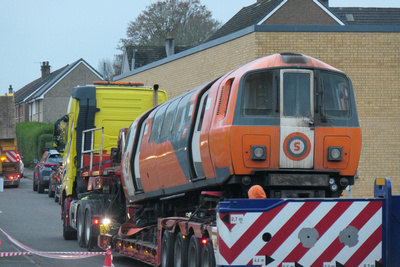
 A couple of days after the final withdrawal of the final 2nd generation stock, cars 119, 203 and 103, which operated on the final day in service were moved to open storage at Edmiston Drive to await their fate with some of the other withdrawn cars.
A couple of days after the final withdrawal of the final 2nd generation stock, cars 119, 203 and 103, which operated on the final day in service were moved to open storage at Edmiston Drive to await their fate with some of the other withdrawn cars.
A second batch of cars were taken to JR Adams Scrap yard on week beginning 29th July, including: 101, 103, 104, 113, 116, 119, 132, 203 and 205.
Following the final day of service for the G2 fleet, Stadler advertised the remaining cars up for sale for £5,000 per vehicle (fee waived for charities) with costs for low loaders, cranes etc on top of that. During week beginning 4th November, Railway Lawyer and Enthusiast Ben Denton-Cardew and local MSP Paul Sweeney announced that around half of the fleet had been saved and allocated to a number of different small businesses, schools and charities for a variety of different purposes. Paul Sweeney MSP said:
“After a number of months of persistence and negotiation, we have successfully averted half of the fleet of 1980s Metro-Cammell Glasgow Subway cars from being condemned to the scrap yard.
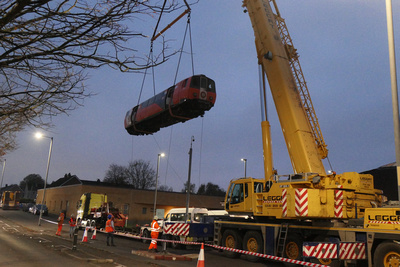
 “These old carriages are adored by Glaswegians and are a central part of our social history. It would not have been right to allow these carriages to be discarded.”
“These old carriages are adored by Glaswegians and are a central part of our social history. It would not have been right to allow these carriages to be discarded.”
The cars that are have been saved are: Metro Cammell motor cars: 105, 106, 107, 110, 111, 112, 117, 118, 120, 121, 124, 125, 126, 129, 130 and 133 and Barclay Trailers 202, 204, 206 and 207.
The remaining cars were transferred by low loader from the Stadler Compound at Edmiston Drive to Glasgow Works in Springburn, for storage until distribution to their new homes was arranged. The first cars began to be transferred to their new homes on 6th November.
Most of the cars are remaining within the Glasgow area, with a few finding new homes in England.
Future Developments
With the withdrawal of the 2nd Generation stock, it was down to the 3rd Generation units to fully operate the service. There was a few teething problems, which was to be expected with not only new stock, but bespoke items of rolling stock.

 One such problem was the many reports of lively running with the trains swaying as they make their ways through the tunnels. It appears to be more noticable in the centre and rear portions of the trains. SPT announced in July 2024 that they were working on a programme to install dampers to the trains to try and cut down on the bouncing and swaying!
One such problem was the many reports of lively running with the trains swaying as they make their ways through the tunnels. It appears to be more noticable in the centre and rear portions of the trains. SPT announced in July 2024 that they were working on a programme to install dampers to the trains to try and cut down on the bouncing and swaying!
The introduction of the new trains is not the end of the modernisation of the Subway. The next phase will involve the installation of a new signalling system, which will allow more trains to operate. Currently, the maximum number of trains allowed per circle is 6 and in the future, 8 trains per circle could run.
With the introduction of the new signalling system, the next phase will involve the installation of plaform screens on each station platform, with the screen doors lining up with the train doors and only opening when the trains are stopped in the station and should improve safety and comfort for passengers, particularly on the narrow island platforms.
With the completion of all the modernisation works, it is intended that all trains will be driverless, with a member of staff still on board for safety reasons and as a backup.
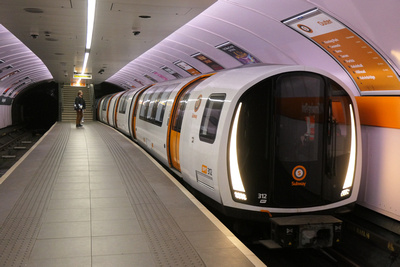
 Once the new Stadler stock is fully in service and a new signalling system is commisioned, the next phase of work will be the fitting of platform screens at each station platform, with screen doors that will line up with the doors of the trains, hopefully improving safety and comfort for waiting passengers. It is intended that in the future that all trains will be driverless, with a set of back up controls available in case they are needed.
Once the new Stadler stock is fully in service and a new signalling system is commisioned, the next phase of work will be the fitting of platform screens at each station platform, with screen doors that will line up with the doors of the trains, hopefully improving safety and comfort for waiting passengers. It is intended that in the future that all trains will be driverless, with a set of back up controls available in case they are needed.
Set 313 is currently being held back from entering passenger service to test the new signalling and station arrangements up on the surface on the test track at Edmiston Drive.
Going driverless, will involve the removal of the temporary cabs currently fitted to the new stock, allowing a forward or rear view for passengers lucky enough to grab the front seats! It is expected that the new signalling system will eventually allow trains to be called from or recalled to depot automatically to meet the requirements of the service. The completion of the modernisation will allow for the extension of the current opening hours, particularly on Sundays, where the current finish time is 6pm.
All in all, this small and unique system is worth a visit, particularly prior to the installation of the platform screens, which will make photography on the system more problematic.
Generation 2 and 3 fleet lists.
Generation 2: Met Cam and Barclay Fleet List
| Number | Vehicle Type | Built by | Entered Service | Current Livery | Withdrawal Date | Status | Notes |
| 101 | Motor Car | Metro Cammell | 16.4.1980 | Download Railway Guardian all over advert livery | June 2024? |
Scrapped August 2024 |
Stored in Stadler Compound, Edmiston Drive till 1st August 2024 when moved to S Norton Scrapyard, KGV Docks, Govan. |
| 102 | Motor Car | Metro Cammell | 16.4.1980 | SPT Orange, Grey and White livery | March 2024 | Scrapped April 2024 | Stored in Stadler Compound, Edmiston Drive till 12th April 2024 when moved to S Norton Scrapyard, KGV Docks, Govan |
| 103 | Motor Car | Metro Cammell | 16.4.1980 | SPT Orange, Grey and White livery | 28th June 2024 |
Scrapped August 2024 |
rear vehicle in 3 car formation with 119 & 203 on final G2 stock working on Outer Circle 28.6.24. Moved to Storage in Stadler Compound, Edmiston Drive till 1st August 2024 when moved to S Norton Scrapyard, KGV Docks, Govan |
| 104 | Motor Car | Metro Cammell | 16.4.1980 | SPT Net Zero Commitment livery | June 2024 | Scrapped August 2024 | Stored in Stadler Compound, Edmiston Drive till 1st August 2024 when moved to S Norton Scrapyard, KGV Docks, Govan |
| 105 | Motor Car | Metro Cammell | 16.4.1980 | SPT Orange, Grey and White livery | June 2024 | Preserved | Hidden Lane, Finnieston, Glasgow |
| 106 | Motor Car | Metro Cammell | 16.4.1980 | SPT Orange, Grey and White livery | 28th June 2024 | Stored | front vehicle in 3 car formation with 207 & 120 on final G2 stock working on Inner Circle 28.6.24. In storage at RSS yard, Wishaw (England) |
| 107 | Motor Car | Metro Cammell | 16.4.1980 | SPT Orange, Grey and White livery | 11th June 2024 | Preserved | Preserved: Northumbria Rail, Northumbria |
| 108 | Motor Car | Metro Cammell | 17.4.1980 | SPT Orange, Grey and White livery | March 2024 | Scrapped April 2024 | Stored in Stadler Compound, Edmiston Drive till 12th April 2024 when moved to S Norton Scrapyard, KGV Docks, Govan |
| 109 | Motor Car | Metro Cammell | 18.4.1980 | SPT Orange, Grey and White livery | March 2024 |
Scrapped April 2024 |
Stored in Stadler Compound, Edmiston Drive till 12th April 2024 when moved to S Norton Scrapyard, KGV Docks, Govan |
| 110 | Motor Car | Metro Cammell | 16.4.1980 | SPT Orange, Grey and White livery | June 2024 | Preserved | Hidden Lane, Finnieston, Glasgow |
| 111 | Motor Car | Metro Cammell | 16.4.1980 | SPT Orange, Grey and White livery | 11th June 2024 | Preserved | Hidden Lane; Finnieston, Glasgow |
| 112 | Motor Car | Metro Cammell | 16.4.1980 | SPT Orange, Grey and White livery | June 2024 | Stored | In storage at RSS yard Wishaw (England) |
| 113 | Motor Car | Metro Cammell | 16.4.1980 | SPT Orange, Grey and White livery | June 2024 | Scrapped August 2024 | Stored in Stadler Compound, Edmiston Drive till 1st August 2024 when moved to S Norton Scrapyard, KGV Docks, Govan |
| 114 | Motor Car | Metro Cammell | 16.4.1980 | SPT Orange, Grey and White livery | March 2024 | Scrapped April 2024 | Stored in Stadler Compound, Edmiston Drive till 12th April 2024 when moved to S Norton Scrapyard, KGV Docks, Govan |
| 115 | Motor Car | Metro Cammell | 16.4.1980 | SPT Orange, Grey and White livery | 27th March 2023 | Scrapped April 2024 | Stored in Stadler Compound, Edmiston Drive till 12th April 2024 when moved to S Norton Scrapyard, KGV Docks, Govan |
| 116 | Motor Car | Metro Cammell | 16.4.1980 | SPT Orange, Grey and White livery | June 2024 |
Scrapped August 2024 |
Stored in Stadler Compound, Edmiston Drive till 1st August 2024 when moved to S Norton Scrapyard, KGV Docks, Govan |
| 117 | Motor Car | Metro Cammell | 17.4.1980 | SPT Orange, Grey and White livery | June 2024 | Preserved | Beatroute Arts Centre, Glasgow |
| 118 | Motor Car | Metro Cammell | 16.4.1980 | Scottish Power / COP 26 advert livery | June 2024 | Stored | Stored, Springburn Works |
| 119 | Motor Car | Metro Cammell | 16.4.1980 | SPT Orange, Grey and White livery | 28th June 2024 | Scrapped August 2024 | front vehicle in 3 car formation with 203 & 103 on final G2 stock working on Outer Circle 28.6.24. Moved to Storage in Stadler Compound, Edmiston Drive till 1st August 2024 when moved to S Norton Scrapyard, KGV Docks, Govan |
| 120 | Motor Car | Metro Cammell | 16.4.1980 | SPT Orange, Grey and White livery | 28th June 2024 | Preserved |
rear vehicle in 3 car formation with 106 & 207 on final G2 stock working on Inner Circle 28.6.24. Preserved, Hutcheson's Grammar |
| 121 | Motor Car | Metro Cammell | 16.4.1980 | SPT Orange, Grey and White livery | June 2024 | Preserved | Hidden Lane, Finnieston, Glasgow |
| 122 | Motor Car | Metro Cammell | 19.11.1980 | N/A | 2015 | Scrapped 2017 | Withdrawn 2015 and scrapped circa 2017 to provide spare parts for other vehicles |
| 123 | Motor Car | Metro Cammell | 16.4.1980 | SPT Orange, Grey and White livery | March 2024 | Scrapped April 2024 | Stored in Stadler Compound, Edmiston Drive till 12th April 2024 when moved to S Norton Scrapyard, KGV Docks, Govan |
| 124 | Motor Car | Metro Cammell | 18.4.1980 | SPT Orange, Grey and White livery | June 2024 | Preserved | Ivy in the Park Nursery, Glasgow |
| 125 | Motor Car | Metro Cammell | 16.4.1980 | Scottish Power / COP 26 advert livery | June 2024 | Stored | Stored, Springburn Works |
| 126 | Motor Car | Metro Cammell | 16.4.1980 | SPT Orange, Grey and White livery | June 2024 | Preserved | Private site, Cambridgeshire |
| 127 | Motor Car | Metro Cammell | 16.4.1980 | SPT Orange, Grey and White livery | 18th June 2023 | Scrapped April 2024 | Stored in Stadler Compound, Edmiston Drive till 12th April 2024 when moved to S Norton Scrapyard, KGV Docks, Govan |
| 128 | Motor Car | Metro Cammell | 16.4.1980 | SPT Orange, Grey and White livery | 10th June 2024 |
Preserved |
Preserved and on display at the Riverside Museum, delivered 13th June 2024. |
| 129 | Motor Car | Metro Cammell | 18.4.1980 | SPT Orange, Grey and White livery | June 2024 | Preserved | Preserved: Northumbria Rail, Northumbria |
| 130 | Motor Car | Metro Cammell | 16.4.1980 | Glasgow Subway 1896-2016 120 years All over Grey livery with orange doors | June 2024 | Stored | Stored, Springburn Works |
| 131 | Motor Car | Metro Cammell | 18.4.1980 | SPT Orange, Grey and White livery | 4th August 2023 | Scrapped April 2024 | Stored in Stadler Compound, Edmiston Drive till 12th April 2024 when moved to S Norton Scrapyard, KGV Docks, Govan |
| 132 | Motor Car | Metro Cammell | 16.4.1980 | SPT Net Zero Commitment livery | June 2024 |
Scrapped April 2024 |
Used for the Inaugaration of the new system by the Queen 1.11.79. Moved to Storage in Stadler Compound, Edmiston Drive till 1st August 2024 then moved to JR Adams Scrap Yard |
| 133 | Motor Car | Metro Cammell | 16.4.1980 | SPT Orange, Grey and White livery | June 2024 | Preserved | Used for the Inaugaration of the new system by the Queen 1.11.79. Hidden Lane, Finnieston, Glasgow |
| 201 | Trailer | Hunslet Barclay | 26.10.1992 | Scottish Power / COP 26 advert livery | June 2024 | Scrapped August 2024 | |
| 202 | Trailer | Hunslet Barclay | 17.11.1992 | SPT Orange, Grey and White livery | June 2024 | Preserved | Hidden Lane, Finnieston, Glasgow |
| 203 | Trailer | Hunslet Barclay | 26.10.1992 | SPT Orange, Grey and White livery | 28th June 2024 | scrapped August 2024 | centre vehicle in 3 car formation with 119 & 103 on final G2 stock working on Outer Circle 28.6.24. Moved to Storage in Stadler Compound, Edmiston Drive till 1st August 2024 when moved to S Norton Scrapyard, KGV Docks, Govan |
| 204 | Trailer | Hunslet Barclay | 11.11.1992 | SPT Net Zero Commitment livery | June 2024 | Preserved | Hidden Lane, Finnieston, Glasgow |
| 205 | Trailer | Hunslet Barclay | 26.10.1992 | SPT Orange, Grey and White livery | June 2024 | Scrapped August 2024 | Stored in Stadler Compound, Edmiston Drive till 1st August 2024 when moved to S Norton Scrapyard, KGV Docks, Govan |
| 206 | Trailer | Hunslet Barclay | 26.10.1992 | SPT Orange, Grey and White livery | June 2024 | Preserved | Hidden Lane, Finnieston, Glasgow |
| 207 | Trailer | Hunslet Barclay | 27.10.1992 | SPT Orange, Grey and White livery | 28th June 2024 | Stored | centre vehicle in 3 car formation with 106 & 120 on final G2 stock working on Inner Circle 28.6.24. Stored, Springburn Works |
| 208 | Trailer | Hunslet Barclay | 2.12.1992 | SPT Orange, Grey and White livery | March 2024 | Scrapped April 2024 | Stored in Stadler Compound, Edmiston Drive till 12th April 2024 when moved to S Norton Scrapyard, KGV Docks, Govan |
Engineering Fleet
| Number | Type | Entered Service | Notes |
| L2 | Locomotive | 1978 | Clayton 4 Wheel Battery Locomotive |
| L3 | Locomotive | 1978 | Clayton 4 Wheel Battery Locomotive |
| L4 | Locomotive | 1978 | Taylor Woodrow 4 Wheel Battery Locomotive |
| L6 | Locomotive | 2010 | Clayton 4 Wheel Battery Locomotive |
| L7 | Locomotive | 2010 | Clayton 4 Wheel Battery Locomotive |
| CEB4642A | Locomotive | 2017 | Clayton 4 Wheel Battery Locomotive |
| CEB4642B | Locomotive | 2017 | Clayton 4 Wheel Battery Locomotive |
| W2 | Wagon | 1983 | Rail Transporter Wagon: ex Gripper/ G1 Motor 2 |
| W16 | Wagon | 1978 | Cable Laying Wagon: ex Gripper/ G1 Motor 16 |
| W20 | Wagon | 1983 | Rail Transporter Wagon: : ex Gripper/ G1 Motor 20 |
| W57 | Wagon | 1978 | Cable Laying Wagon: ex Gripper/ G1 Motor 57 |
| W5 | Wagon | 1992 | 4 Wheel Flat Wagon |
Generation 3: Stadler Fleet List
| Number | Vehicle Type | Built by | Entered Service | Current Livery | Status | Notes |
| 301 | Unit | Stadler | 2024 | White with black window surrounds & cab ends and orange doors | in service | entered service Feb 2024 |
| 302 | Unit | Stadler | 2023 | White with black window surrounds & cab ends and orange doors | in service | entered service 11.12.23 |
| 303 | Unit | Stadler | 2024 | White with black window surrounds & cab ends and orange doors | in service | entered service Feb 2024 |
| 304 | Unit | Stadler | 2024 | White with black window surrounds & cab ends and orange doors | in service | entered service March 2024 |
| 305 | Unit | Stadler | 2024 | White with black window surrounds & cab ends and orange doors | in service | entered service March 2024 |
| 306 | Unit | Stadler | 2023 | White with black window surrounds & cab ends and orange doors | in service | entered service 11.12.23 |
| 307 | Unit | Stadler | 2024 | White with black window surrounds & cab ends and orange doors | in service | entered service March 2024 |
| 308 | Unit | Stadler | 2024 | White with black window surrounds & cab ends and orange doors | in service | entered service April 2024 |
| 309 | Unit | Stadler | 2024 | White with black window surrounds & cab ends and orange doors | in service | entered service April 2024 |
| 310 | Unit | Stadler | 2024 | White with black window surrounds & cab ends and orange doors | in service | entered service April 2024 |
| 311 | Unit | Stadler | 2024 | White with black window surrounds & cab ends and orange doors | in service | entered service June 2024 |
| 312 | Unit | Stadler | 2024 | White with black window surrounds & cab ends and orange doors | in service | entered service June 2024 |
| 313 | Unit | Stadler | White with black window surrounds & cab ends and orange doors | not entered service yet | In Stadler compound at end of the test track | |
| 314 | Unit | Stadler | White with black window surrounds & cab ends and orange doors | in service | entered service Sept 2024 | |
| 315 | Unit | Stadler | White with black window surrounds & cab ends and orange doors | in service | entered service Sept 2024 | |
| 316 | Unit | Stadler | White with black window surrounds & cab ends and orange doors | in service | entered service July 2024 | |
| 317 | Unit | Stadler | White with black window surrounds & cab ends and orange doors | in service | entered service July 2024 |